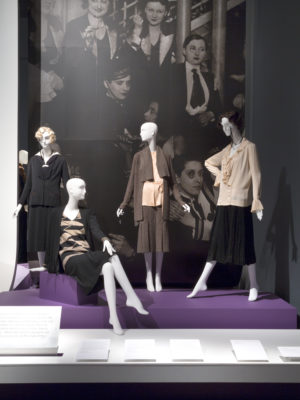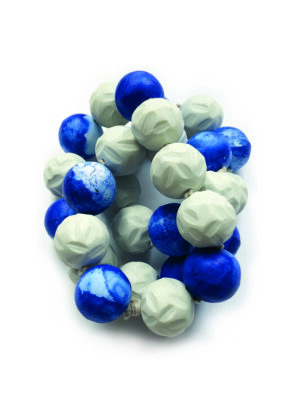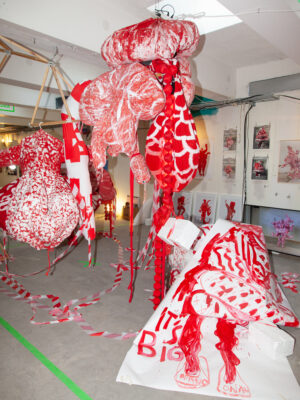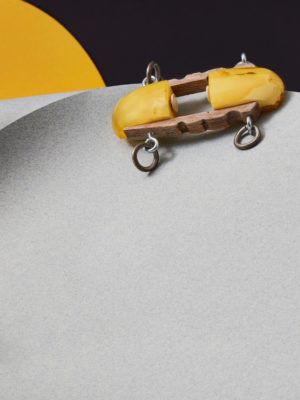Through thoroughly researched exhibitions fashion exceeds its superficial image and can inform us about the current or historical zeitgeist in which it was created. A leading figure in the fashion curation world is Dr. Valerie Steele, so if you want to learn more, she is the person to talk to. Steele is the longtime chief curator (since 1997) and director (since 2003) of the museum at FIT, the Fashion Institute of Technology in New York City. From 1997 onwards she has curated over 25 exhibitions, including The Corset and A Queer History of Fashion: From Closet to Catwalk, and her list of books and articles is even longer.
However, it was not always a walk in the park. It was at Yale Graduate School that she had her ‘aha-moment’ regarding the dissertation topic for her Ph.D. in Modern European Cultural and Intellectual History: fashion. She figured that fashion was a part of culture and thus a worthy topic. However, she encountered resistance. Fashion was not acknowledged as a serious subject of study and was considered ‘frivolous, sexist, bourgeois, ‘material’ (not intellectual)’. She illustrates an encounter with a professor at Yale in her 1991 article The F-Word:
“Once, when I was a graduate student at Yale, a history professor asked me about my dissertation. ‘I’m writing about fashion,’ I said. ‘That’s interesting. Italian or German?’ It took me a couple of minutes, as thoughts of Armani flashed through my mind, but finally I realized what he meant. ‘Not fascism,’ I said, ‘Fashion. As in Paris.’ ‘Oh.’ There was a long silence, and then, without another word, he turned and walked away.”
___STEADY_PAYWALL___
Yet Steele prevailed and received her Ph.D. on The Erotic Aspects of Victorian Fashion. She continued her studies with a post-doc at the Smithsonian and worked for many institutions. Throughout her career she has raised public awareness of the cultural and social significance of fashion. In 1997 she provided an arena for the like-minded when she founded the first peer-reviewed academic journal on fashion, Fashion Theory: the journal for dress, body & culture. There you go, a force to reckon with.
Current Obsession talked to Dr. Valerie Steele and got a peek into her brilliant mind.
Renee van der Hoek (RH)
You’ve created more than 25 exhibitions; the majority are thematic exhibitions. Why do you tend to focus on the thematic rather than the designer retrospective?
Valerie Steele (VS)
Well, designer retrospectives are, in a sense, the easiest ones. They are certainly the easiest for the public to understand, particularly if it’s a famous name. We have done a few, but not of famous names: more obscure, ‘arty’ designers like Isabel Toledo or Ralph Rucci. But, the problem with doing a retrospective on a designer is, first of all, they never want to do a retrospective. They don’t want it to trace their career, they want it to be just the highlights and organised thematically.
Which leads you to the next thing: it’s their name and they want to control what you say about it. So even if you’re good friends with them, even if you admire them tremendously, it’s never really your show. It’s a compromise between your idea of them and their idea of them. And that’s fine. It can still be a very worthwhile show. I’ve certainly seen and worked on some really good individual designer shows, but it seems to me that you can say things more freely and perhaps larger and more interesting things when you’re dealing with a thematic topic – or, say, comparing two designers from the past, which can be a standard art historical trope. You can often say more by comparing than just by focusing on one. So, my colleague, for example, did one on Halston and Yves Saint Laurent. I contributed to another one on Halston and Andy Warhol. It was interesting being able to do that comparison.
RH
That explains why many curators often say the best designers to work with are already dead!
VS
Even then, there may be a widow at work! And if the company is still around, you’re dealing with the company, which can be very protective about their brand image.
RH
Therefore, by focusing more on the thematic you’re more in control on the narrative?
VS
We can ask more complicated and sophisticated questions that have answers which are not so propagandistic.
RH
You’ve talked in many interviews about the power of collaboration and today we live in a world where many different voices and views can and should be heard. I’m curious to hear how you think the role of the curator might change in the future?
VS
I think the role of the curator is changing. I don’t believe that curators should absolutely cede authority. I mean, the curator is part of a production, like the author producing a book. The curator produces an exhibition but does it in collaboration with other people ranging from the registrar to the conservator to the set designer. I think that bringing in specialised forms of expertise and different voices can only be helpful to the curator or inform things.
So, for example, when I did A Queer History of Fashion, I made sure I had an advisory council: LGBTQ+ activists, people who were gay, people who were historians of LGBTQ+ history or theory. It was hugely helpful to me to have those voices and it was really fascinating. If I do end up doing a show on psychoanalysis in fashion, I’ve already started talking with psychoanalysts and saying things like, ‘I’m a fashion historian, I’m not a shrink. I want to hear what you think are different approaches that I could take. I’ve read a ton of Freud. I’m having a really hard time with Lacan. I’m reading some Melanie Klein and some of it sounds cool and some of it sounds completely insane. So, I need your help to try and process some of this material.’
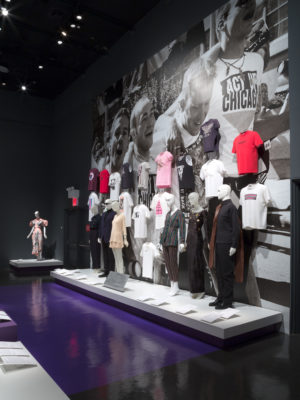
RH
You’ve been making exhibitions for many years. Could you share some of your thoughts on the changes during that time in exhibition design and, moreover, in the visitor experience? I can imagine that’s a challenge today, what the visitor wants and expects.
VS
The visitor wants and expects more and more, even though only a handful of museums and couture houses have the money to spend on a really big exhibition with an amazing mis en scène and lots of audio-visual effects. And the vast majority of museums simply can’t afford anything remotely approximating that. It’s no longer enough to just have a white cube with platforms and mannequins on them.
You have to have more. I think that’s the main difference. Some shows are more austere than others and there’s definitely different sorts of national trends. People like to watch TV and like to watch videos. I mean, that’s something which is kind of discouraging in some ways. As a museum, you are trying to say: ‘Here’s your once in a lifetime chance to see this actual object in front of you!’ And they will look at the actual object, but then they’ll actually spend more time looking at the videos. So that’s something that you kind of just have to deal with. People really want that.
People like to watch TV and like to watch videos. I mean, that’s something which is kind of discouraging in some ways. As a museum, you are trying to say: ‘Here’s your once in a lifetime chance to see this actual object in front of you!’ And they will look at the actual object, but then they’ll actually spend more time looking at the videos. So that’s something that you kind of just have to deal with. People really want that.
RH
Do you think that they’re losing their relation to objects?
VS
Well, they’re just used to seeing clothes in certain venues. You see clothes on bodies of real people: yourself and your friends. You see fashion on the screen: whether it’s the computer screen or a movie. You see it in motion, being worn by charismatic people like fashion models or actors. And you see it hanging in stores, where you can grab it and try it on. So, it has an immediate tactile value. What’s valuable about museums, but also frustrating for some people, is that you see it, but it’s on a still mannequin. It’s not like a store, it’s not like real life. It’s a chance to view it as an object, maybe as an art object. People sometimes tell us that it’s like a dead object, it’s not moving. I think the videos make them say, ‘Oh it can move! I like to watch it when it’s moving.’
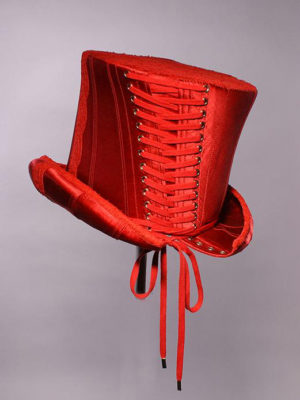
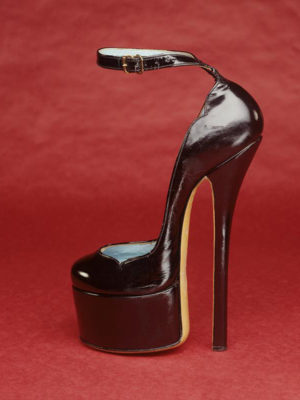
RH
Because of social media we can also argue that the stage has shifted. The new aim is to create the next ‘viral image’. A lot of fashion nowadays seems to be designed for the frontal image. How do you think this will develop?
VS
Yes, absolutely. You’ve certainly seen designers start looking for clothes that will show up well on a small screen. So, more colour, more pattern, more of a clear silhouette for that look. Black is very difficult, because you can’t see the details. For exhibitions also, we’ve seen the desire for an Instagrammable moment within the exhibition. Already several years ago I had to coax my chief conservator into allowing people to take photographs, because traditionally in museums they’ve not allowed people to take photographs. We said, ‘No, but it’s a great form of free publicity.’ They don’t want an experience that they can’t take a selfie in. So, we said, ‘Okay, no selfie sticks, no flash, no video. But yes, you can take as many pictures as you want.’ Then you try to arrange the show so there’s at least one or two moments where you can go ‘Here’s an Instagrammable moment!’ I really had that epiphany a couple years ago when I was in Shanghai, and they set up specific Instagram moments in the art exhibition and I was like, ‘That’s so true: your audience wants that, so you might as well give it to them.’
Marina Elenskaya (ME)
Instagram has created opportunities for people to look more closely at small details like nail designs and jewellery and makeup. It allows you to better see the changes they make to an ensemble and the dynamics between them. I would like to hear your opinion on this, and then maybe on how big brands are responding to it?
VS
Every little piece of the fashion ensemble has always been important: the tiny earring, the hair, the eyebrows. But now, with Instagram, with all kinds of new filters and with high definition, you can see that so much more clearly. So, the fragmentation of the fashion image has been part of things for a very long time. I used to think that it had been since the 1970s, with Guy Bourdin and this kind of surreal breaking up of the body. But I was just glancing at a book about Manet and I was pulling out my old page markers and there was one talking about focusing on the detail. The Impressionists were doing it too! We’re used to looking at the fragment as a small part of the whole. Years ago, the exhibition designer Judith Clark did a beautiful show on maligned muses in Antwerp that she later took to London as Spectres: When Fashion Turns Back. She had a section where you could look through this magnifying lens and see the lace collar of a dress blown-up. She said that designers, when they look at the past, may focus just on one detail, not the whole dress: it’s just that beautiful lace collar. So why not help your viewer have some of that same thing? After I saw that show, I came home and pulled my staff together and said ‘New paradigm! We have to think about how viewers are going to be looking at things and how to catch their attention.’
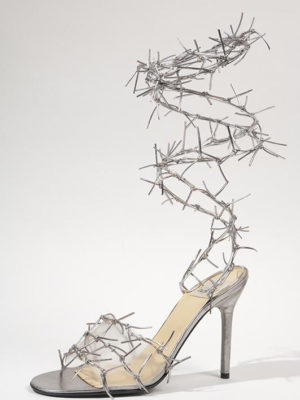
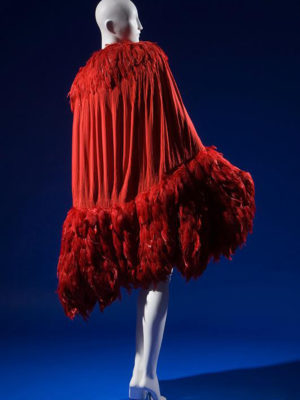
RH
It gives you an opportunity to really zoom in and look at all the details?
VS
Yes, details are often what makes the difference between something that’s really good and something that’s just good.
In the Paris show, we have a real couture Chanel suit and a licensed copy from a department store in New York back in the 60s. We used to show these to students but eventually it was too much wear and tear on these two suits. So, we put together a presentation where we show a detail: ‘Here’s a hand-sewn button-hole. Here’s the machine-sewn one on the copy. Here’s the beautiful original metal button for the couture suit. Here’s the cheaper one where the metal is wearing off.’ These close-up images were actually more effective, so we also put them into the show so you could see the tiny little differences that made up the big difference between a licensed ready-to-wear copy and the couture original.
RH
How would you describe the contemporary dynamics between fast fashion and the luxury industry? We can see that the luxury industry tends to focus again on craft, even buying and securing traditional haute couture ateliers.
VS
Of course, they want to make something that is not so easily copyable. It’s interesting because luxury has historically tended to have to do with rarity, among other things, not just fine craftsmanship and fine materials but sheer rarity. So that the materials are something that you can’t get easily. Now, the diamond industry has been very clever promoting ‘a diamond is forever,’ because in fact there’s shitloads of diamonds around. It’s not a rare thing. But they made everybody believe that diamonds are rare. And similarly, with luxury fashion items, if you restrict the number of handbags that you produce, then they become rare. By virtue of them not producing very many, they become more desirable.
For some people, the rarity value will be increased by the knowledge of the story of the handcraftsmanship behind it, particularly if you have a believable story about it being made by well-paid artisans in Western Europe. The problem is, there’s been a lot of lying and greenwashing going on. In fact, a lot of the surface decoration is done in India or Bangladesh by children or by Syrian refugees in Turkey. So, with a lot of companies, frankly, the chain of production is not transparent at all.
ME
Because they would say it is being assembled somewhere in Italy.
VS
Yeah, maybe the label is sewn on in Italy. But maybe it’s sewn on in Italy by refugees or exploited immigrants there. Even some very prestigious brands have a very dirty trail of who’s actually making stuff. That causes people to start to wonder which things are real luxury and what does that mean? They’re also interested in buying things that are not exploitative, dangerous to the environment, cruel to animals, et cetera.
ME
But, with this bad reputation that the fashion industry has, do you feel like it is an honest process for them to clean the slate? Or is it more of a political thing?
VS
It’s a mixture of both. There’s no question that there are some companies and some individuals who are really genuinely trying to make it cleaner and more transparent, and others who just want it to look that way so they can sell more things.
RH
…and to follow the current trend of sustainability. However, it’s also a complicated statement: ‘sustainable.’
VS
Yes, there are so many components to sustainability. For example, I’ve been told by some sustainability officers, ‘Well with snakeskin, python is fine.’ And I know that pythons are like, taking over the Florida Everglades, they’re eating everyone’s dogs, they’re eating their toddlers. There are pythons in Southeast Asia that are being hunted in the jungle because it’s still cheaper than raising them on a snake farm, which takes a long time. I am a fashion expert and I don’t know if I could buy a pair of snakeskin boots or not. Because, is it being taken out of the jungle in Indonesia and devastating that whole ecosystem? Or is it being harvested in Florida or grown on a snake farm? I don’t know. There is no international seal of approval that tells you where the bloody snakeskin came from.
ME
On another note, two years ago, Victoire de Castellane spoke at the Jewellery Matters symposium at the Rijksmuseum. She was talking about ‘high jewellery’ in connection to fashion and this whole understanding of jewellery being part of a fashion house. How and why does the understanding of what ‘luxury’ is change?
VS
Well, the big luxury fashion companies like Dior and Chanel and LVMH are definitely realizing that what the industry calls ‘hard luxury,’ (i.e. jewellery and watches) are really the most recession-proof. Because you can mix high and low with your clothes; you can wear blue jeans with an expensive jacket – and they can be expensive Louis Vuitton blue jeans – but when you’re with really rich people, they can tell the difference between fake and real jewellery and they value that. Most ordinary people don’t really have a chance to spend a lot of time with expensive jewellery, so that is a really important indicator that rich people can see. I mean, guys who know nothing about fashion will be able to tell an expensive watch from a cheap watch. Although there used to be separate jewellers like Cartier, and they continue to exist, it’s been a brilliant stroke of genius for luxury fashion houses to branch out into hard luxury.
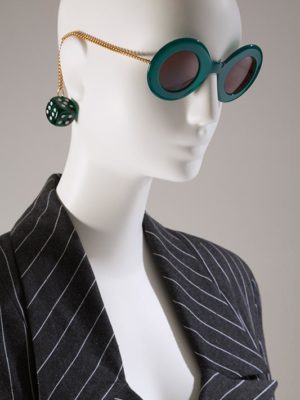
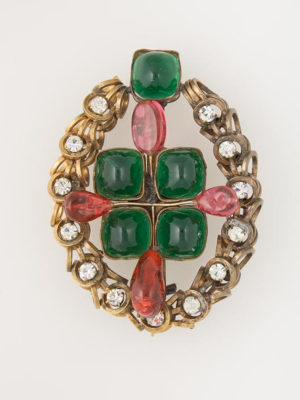
ME
What is opposed to hard luxury? Soft luxury?
VS
Soft luxury means things like clothing. But that goes up and down. How much do people really care about that when they can get the fast fashion version? Often, the fast fashion copy will come out six months before the original! Now, if you’re a really good friend of the fashion house and you can get it off the runway, then it’s obviously better to get the high fashion one. But otherwise, maybe it’s more bang for your buck to get the fast fashion one, wear it once and throw it away and then onto the next thing. So, it’s not necessary. People are proud of saying that one thing they are wearing is real and another is fast fashion: ‘I mix. I’m not a fashion victim.’
ME
In the end, fashion is way of expressing yourself and everyone wants to stand out. But obviously it’s not a new thing in fashion or adornment. So, I was thinking maybe you could share interesting stories or examples of where, in your experience, fashion has served as a communicator?
VS
Well, for example, with clothing in the 1980s, when the Japanese fashion revolution began and they began to show in Europe rather than just in Tokyo, Rei Kawabuko and Yohji Yamamoto already had a reputation in Tokyo. Their followers were known as the ‘Crow Tribe’ because they dressed all in black. Then they started to show in Paris and at first the journalists were all like, ‘This is horrible, here they are working out at the gym and have these baggy, black, depressing, ripped clothes.’ So, those of us who were interested in Japanese avant-garde fashion, we’d buy it and people would be like, ‘Ew, what’s that?’ But then you’d see somebody else wearing it and it was like a secret Masonic handshake. And you would look at each other. You knew what it was but nobody else did. Part of the appeal was that others didn’t. And that is, I think, what a lot of insider fashion is about.
As soon as more people get it and the wrong people get it then it’s totally over. I remember seeing a cartoon, or something on TV, in the 90s, and one character says, ‘Why is she dressed like an airline stewardess?’ And the guy’s girlfriend goes ‘You idiot! She’s wearing Prada! Can’t you tell, this is high status, high fashion? To you it looks like an airline stewardess, but that’s because you’re a moron!’ I think that this kind of insiderdom has been a big part of fashion. It’s harder to keep that now because all the news gets out right away. Therefore, that aspect has become more complicated and for that reason people have tried finding a group that you identify with instead of following fashion. Preferably one that only some insiders will be able to know about.
ME
To further draw on this notion of secret signs, you mentioned Oscar Wilde as an inspiration for A Queer History of Fashion and how a red tie or a green carnation on the lapel were symbols for gay men to identify each other with without being seen and while staying safe. So, it also has to do with security and safety.
VS
That’s a very important aspect, especially for the LGBTQ+ community. You could communicate with other gay men or other lesbian women without being understood by the wider, probably homophobic, population. So yes, there were definitely things: suede shoes, red ties, bleached hair. Some of them were so obvious that everybody noticed, like men wearing make up – people were like, ‘Hello, what’s up with you?’ In the 1920s this came up in novels. You know, a male character is putting on his makeup in a bar and his female friend is wearing trousers and has short hair and the bar owner asks them to leave because they’re breaking all of these gender roles. With the guy, you assume he’s probably gay, but the woman? Was she a lesbian or was she just being chic in that garçon way?
ME
The Victorian era has many examples of this kind of symbolism, wouldn’t you say?
VS
Well, in regard to the Victorian era clothing has been greatly misunderstood. There’s this idea that the Victorians were totally physically and sexually repressed and they didn’t know that women had legs. Believe me, they knew women had legs. They saw plenty of women’s legs at the ballet, at the circus, or with working class women. But the point was that it wasn’t proper to show your legs except under certain circumstances. When your crinoline swung back and forth, yes you could see your legs, but that was unintentional. Similarly, if you wore an 1870s-type gown with a corset, you definitely saw an exaggerated hourglass figure there. Both the covering up and the exaggeration, the attraction of concealment, appealed to different designers. It seems repressive, but actually it’s sort of in-your-face sexuality once you can interpret it. Then there were things like mourning dress, which were very codified. But even at the time, the Victorians made jokes about how pretty a widow was all in black with her black fan and her black veil. They said she was like a rebaited trap; she’s just trying to catch another man. That her skin looked whiter and more desirable underneath all this clothing.
When I did the Gothic show I showed a lot of mourning dresses, including one that was an evening dress and had a plunging neckline and was very erotic. People said, ‘How can that be a mourning dress?’ And I said, ‘With the rules of the time, the sequins on that dress are not shiny. They are matte sequins and therefore it’s a mourning dress. Shiny would be overtly sexy. It was still a very sexy dress, but it followed the rules.’
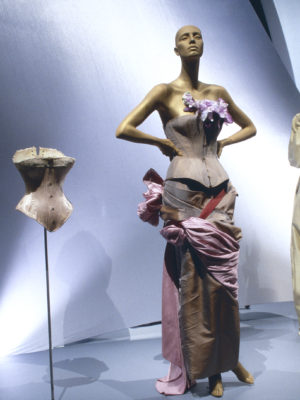
ME
We’re so inspired by what you’ve done for the history of fashion and the ways fashion is perceived. Now we are talking about lots of things changing, things shifting. Do you feel like adornment in general or jewellery could follow a path that sees it becoming an academic subject too?
VS
Oh, I’m surprised it hasn’t already been done in a greater way: that there’s only been a handful of people who have done scholarly work on jewellery. Because it’s so fabulous. It’s really an incredibly rich topic and it’s wildly understudied. For my magazine Fashion Theory, I’ve only gotten a couple of articles about jewellery. I would love to get more articles on jewellery and I’m working in the future on trying to do a big show on the book about fashion and psychoanalysis. Of course, jewellery is a prime symbol that Freud talked about from the beginning, and in my dreams I frequently dream of breaking into houses and stealing jewellery.
ME
I’m going to quote you on that. Fantastic! I just wanted to ask you about the lecture at the Rijksmuseum. Everyone is so curious here as to what will happen.
VS
I’m still writing the lecture, but basically the idea is ‘Why fashion matters.’ There was a book about why jewellery matters, so I’m using that as kind of a prototype to try and figure out some of the similarities. Because, they [Marjan Unger and Suzanne van Leeuwen] point out that jewellery has existed at all times and in all places. There has always been some form of body adornment, even if it was only beads and flowers. Fashion has not existed in all times and places. Fashion is usually thought of as being a modern phenomenon, in contrast to traditional dress. But these ideas are getting re-explored and modified slightly. So, I’m trying to look at why fashion and dress and adornment in general matter, and to ask if there are ways that modern fashion differs from more traditional forms of dress. In general, we’re often talking about the same kinds of things, particularly when you get into the symbolic and even unconscious significance of dress and adornment.
So, I’m very interested not only in looking at history and sociology and fashion and art history, but really looking at psychology and psychoanalysis to try and find reasons for why we cover up, and why concealment can, in fact, be erotic. To what extent is there sexual symbolism in dress? Or is that passé now because we know so much about how to read it? Or are we still responding? Some of the early ideas about sexual symbolism in dress were quite crude, but maybe if you look at it in a somewhat more nuanced way, you’ll still find that you’re signalling certain things about the kind of person you are. Even though it’s not as obvious.
For example, I once asked a group of leather fetishists [S&M leather fetishists] what they thought about Versace’s 1992 leather collection? You know, with all the bondage straps. They said, ‘We hate it.’ I said, ‘Really? I thought you would have liked it. I mean, it’s so similar to what you guys wear.’ And they said ‘Yeah, but now you can’t tell whether someone’s really into something or whether they’re just making a fashion statement.’ And I said, ‘Well, suck it up because fashion is like a vacuum cleaner. It just hoovers up every good look.’ It brings in every subcultural look and makes it part of this fashion vocabulary. So, it will carry elements of that ‘perverse’ sexuality, but that’s not its only meaning, it could also just be: this = sexy!
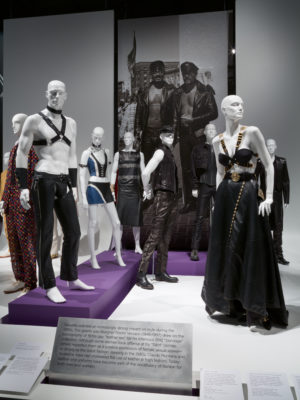
Paris, Capital of Fashion is curated by Dr. Valerie Steele and runs from September 6, 2019 until January 4, 2020 at the special exhibitions gallery at The Museum at FIT in New York.
The Rijksmuseum has invited Valerie Steele for the annual Marian Unger Lecture on November 4, 2019.
Renee van der Hoek is a freelance fashion curator, researcher and writer. She works for museums, cultural platforms and independent magazines. She most recently curated the exhibition We’re in this together: fashion designers challenging conventions at Museum Arnhem. Besides her freelance work she is also a fashion history & theory lecturer.
@renee.vanderhoek
This article is published in the OBSESSED! Jewellery Festival Paper.
OBSESSED! is a biennial jewellery festival taking place in various cities across the Netherlands. OBSESSED! unites the best jewellery-related events – museum and gallery exhibitions, talks, fairs, book presentations and artist open studios – into one intriguing programme put together by Current Obsession.
